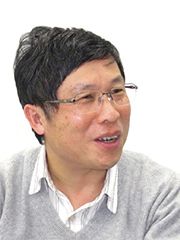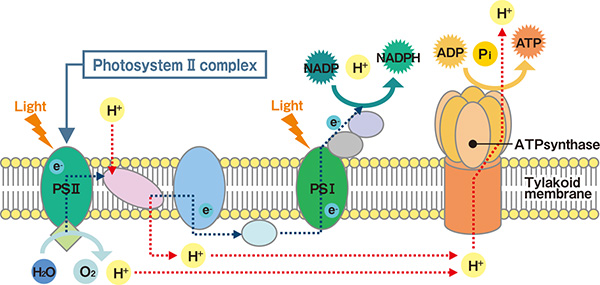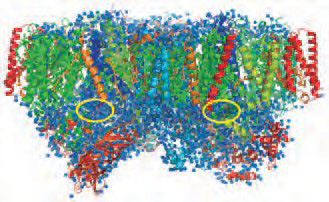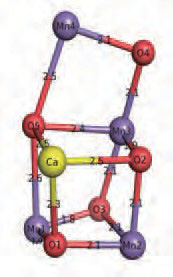Research Results
To solve energy problems
The biggest mystery of photosynthesis has been solved FY2016

- Jian-Ren Shen (Professor, Graduate School of Natural Science and Technology, Okayama University)
- PRESTO
- Structure and Function of Biomolecules
"Molecular mechanisms of bioluminescent energy conversion: Crystal structure analysis of photosystem Ⅱ membrane protein complex" Researcher (2002-2005)
The great challenges too many mysteries of photosynthesis
Photosynthesis is a reaction that breaks down water, produces oxygen, and fixes carbon dioxide in organic compounds, using the energy of light. It is an essential function supporting biological activity on earth. Its fundamental composition was already understood by the late 18th century, but a great deal of research into photosynthesis was still conducted after this time, and by untangling these chemical reactions at the molecular level, we have now come to understand that extremely complex protein groups are responsible. At present, even elementary school students learn about "photosynthesis" in science class. However, the composition of the protein groups responsible for the most important part of the chemical reaction of photosynthesis — the generation of oxygen — long remained an inexplicable mystery.
Professor Jian-Ren Shen worked tirelessly for 20 years to unravel this mystery. In 2011, he finally succeeded in discovering the structure of the photosystem Ⅱ membrane protein group (PS Ⅱ ), the most significant component of photosynthesis. The U.S. scientific journal "Science" selected this result as one of the greatest breakthrough of the year 2011, along with the Hayabusa asteroid probe. This achievement represents a huge step toward the development of technology enabling the artificial control of photosynthesis, and it may even change the entire direction of research and development aimed at energy problem-solving in future.
Process of the light reactions of photosynthesis

Photosynthesis consists of two phases, that is light reactions and dark reactions. In the first step of light reactions, PS Ⅱ makes catalytic,
water is split to produce, oxygen is using a solar energy, synthesis reaction makes oxygen and life action energy.
A long fascination with PS II crystallization & the encounter with"PRESTO"(Sakigake)
In plants, the protein complex responsible for the initial photosynthetic reaction is known as PS Ⅱ, which breaks down water and generates oxygen using energy from light. To unlock the secret of how PS Ⅱ catalyzes* this reaction, it is first necessary to understand the structural subtleties of PS Ⅱ. However, to investigate its structure, it is necessary to extract the PS Ⅱ from the cell without destroying it, which requires an advanced technique for creating high quality crystals. This proved extremely difficult. Professor Shen, whose academic background was in agricultural science, had almost none of the chemistry knowledge or techniques required to achieve this crystallization process; however, he fell under the spell of the 200 year mystery, and over a 20- year period, devoted himself doggedly to research on crystallization. This was undeniably an ongoing period of extraordinary difficulty. In fact, confronting the impending dissolution of the laboratory to which he belonged, Professor Shen even considered abandoning his crystallization research. Facing this dilemma, in 2002 Professor Shen's work was adopted by the PRESTO, which subsequently led to robust support, both financial and mental. Under the PRESTO (Sakigake) program, researchers are selected by a research supervisor, and they receive a great deal of encouragement for the duration of their research. Even when results were not immediately forthcoming during his research, Professor Shen received outstanding evaluations from the research supervisor, which he found very encouraging. Behind his eventual success lay the fundamental philosophy of PRESTO (Sakigake): to support creative and forward-thinking individual-style research.
* Substance that increases the speed of a chemical reaction but does not change itself or its action. It has specificity to create only the desired products.
Overall structural diagram of PS Ⅱ

PSII consists of 19 proteins and there is a symmetrical axis at the center of PSⅡ. The yellow circles indicate the catalytic centers. It was considered to be composed by 4 manganese atoms; however structure of the PSⅡ was not clarified.
A world-level competitive struggle: 1.9Å resolution achieved!
There was tremendously fierce competition with German and English research institutions in the field of crystallization research. The leading edge of this research swung back and forth internationally. The PSⅡ structure was successfully resolved to a level of 3.8Å (Ångstroms. 1Å is 0.1 nanometer. The smaller the value, the more precise the analysis) by the German team in 2001, after which it was resolved by Professor Shen (during he participated in a project) to 3.7Å in 2003, then to 3.5Å by the U.K. in 2004, to 3.0Å by Germany in 2005, and to 2.9Å by Germany again in 2009. In the midst of this seemingly impossible situation, Professor Shen's hard work and dedication finally paid off in 2011, when he rewrote the record books by resolving the structure to the 1.9Å level: a remarkable result indeed.
This 1.9Å value is extremely significant. In truth, the structural layout at the atomic level was actually unknowable at all previous resolutions. However, at the 1.9Å level, it became possible to investigate the type of every single atom, as well as the distance between each atom. As a result of this analysis, it was discovered that the center of the PS Ⅱ enzyme evolution reaction formed an unstable structure resembling a deformed chair comprising four manganese atoms, one calcium atom, and five oxygen atoms. This moment of enlightenment was the breakthrough in 200 years of mystery in the field of photosynthesis research.
The oxygen-evolving catalytic center of "distorted chair structure"

Structure of the oxygen-evolving catalytic center of PS Ⅱ was revealed by Professor Shen. It was found that the catalytic center of PSⅡ consists of four manganese, one calcium, and five oxygen atoms have shape similar to a distorted chair.
Solving the world's energy problems: working toward artificial photosynthesis
The very instability of the structure at the center of the PS Ⅱ reaction is expected to be the long-pursued key to its oxygen generation mechanism. Professor Shen is proceeding further with his research in order to verify this hypothesis. If techniques for artificial photosynthesis can be established in future, then instead of carbon dioxide-generating substances of petroleum and coal, we may be able to achieve clean energy in the truest sense of the words.
Photosynthesis is the foundation and source of all life and activity, and countless organisms owe their existence to it. However, one day it may support our daily lives even further as the foundation stone of energy in the future.
